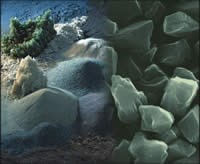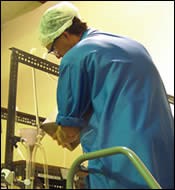Maximizing Finishing Productivity
Hints on how to choose the right abrasive for your grinding and finishing application
Obviously, one type of abrasive will not fit all finishing applications. But, some abrasives will work in many applications. Proper selection of the correct abrasive family will provide:
- The correct amount of stock removal
- Required dimensional accuracy andsurface finish
- The correct relationship between wheel speed, workpiece, power requirement,
and cost - The needed productivity.
What are the abrasive families? Industrial abrasives can be grouped into three basic classes or families of materials. These can be labeled Traditional, Intermediate and Not-so-traditional–the latter encompassing superabrasives.
Traditional abrasives include brown fused aluminum oxide, which is used primarily in grinding of carbon steels with low Rockwell hardness. White fused aluminum oxide is generally used for high-tensile steels, alloy steels and high-speed steels. The aluminum oxide family also includes blends of brown and white oxides for finishing of ferrous materials that fall between the categories listed above.
Another traditional abrasive is silicon carbide. It’s used for materials with low tensile strength, such as cast iron, soft bronzes, aluminum and some cemented carbides.
Seeded-gel aluminum oxide, boron carbide and zirconia-alumina abrasives are commonly found in the Intermediate family. One use for seeded-gel aluminum oxide is finishing of high-tensile alloy steels via creep-feed grinding. Using a properly selected wheel, this process can finish a part in one or two passes.
Boron carbide actually falls between the two superabrasive materials (see below) in hardness. It’s preferred for finishing difficult, highly alloyed carbides and ceramic parts.
Zirconia-alumina abrasives are used in sanding belts and paper, and are useful for cut buffing after machining, deburring, decorative finishes on wood components, and general oxide removal.
Synthetic diamond and cubic boron nitride (CBN) are commonly referred to as superabrasives, mainly because their extreme hardness means the abrasive particles rarely wear out before the bond holding them in place fails.
Diamond materials include monocrystalline, polycrystalline, natural and ultra-detonated diamond. Cubic boron nitride is available in cubic crystal and polycrystalline types.
Diamond is the hardest known material, but it has limitations in finishing applications. An example is grinding of carbon steel when processing temperatures exceed 600°C. Above about 660°C, a chemical reaction results in graphitization of diamond exposed to carbon steel.
Enter CBN, generally considered the premier abrasive material for grinding ferrous metals to precise finishes. In automotive applications, for example, CBN would be the choice for grinding chilled cast iron crankshafts or 1050 steel camshafts.
Synthetic diamond is used throughout industry—for example, in processing of ceramic parts for hip and dental prostheses, as well as for carbide dies for wire drawing and glass processing.
Diamond selection naturally depends on the product being finished and other application specifics. In fluting of decorative crystal, for example, a precise finish is required for appearance of the completed part. This is usually only obtained by a wheel with a hard bond and a non-wearing abrasive, such as synthetic diamond.
Automotive window edging represents another application where diamond abrasives are applied effectively. It requires a precise finish on the window edge to maintain a good seal between the door gasket and window and keep wind, noise, water and dirt out. The edge also must be aesthetically pleasing, and allow opening without leaving a rubber trace on the window. Think about that the next time you roll your car window up or down.
Other common applications for diamond abrasives are peripheral grinding of some tungsten carbide tool inserts and fluting of carbide end mills.
Initially, the main use of CBN was in tooling and cutting of high-speed steels. While still an important application area, CBN has gained acceptance in the automotive and aerospace industries.
Coated Abrasive Selection
As noted earlier, selecting abrasive grains can be a task. In the furniture and woodworking industry, fused aluminum oxide has been proved effective over many years. This abrasive is considered by many as a workhorse and is still relatively inexpensive.
But there are newer alternatives available that may improve productivity. Blending zirconia into the melt during manufacture of fused aluminum oxide produces zirconia alumina, providing additional toughness for longer cutting action. Also available are seeded-gel ceramic abrasives, which are produced using a patented process that results in a tightly controlled microstructure. Each seeded-gel grain contains millions of micron-sized crystallites, allowing them to stay sharp longer during sanding operations and have a controlled breakdown during use that constantly exposes new cutting points.
In furniture finishing applications, the seeded-gel abrasive can provide two to six times the life and a more consistent finish than standard aluminum oxide. One wood furniture manufacturer, for example, reported that the seeded-gel belts ran for six full days as opposed to three days using standard aluminum oxide grain on wide belt sanding machines. In another case, running on a variety of wood types, a manufacturer reported running an average of four days using seeded-gel abrasive compared to less than one day using standard aluminum oxide.
Backing selection is important in belt sanding applications. On sanding machines, cloth-backed coated abrasives are a better choice than paper for several reasons. Cloth backing will stretch, especially on primary contact rolls where wood parts have a tendency to be thick and uneven. Paper backing is a more economical selection when used in platen type sanding equipment where it can produce a high quality finish. In some cases a paper belt with a seeded-gel grain can equal or outperform a traditional aluminum oxide cloth belt.
CBN Selection
Automotive and aerospace applications using CBN abrasives use four main bond systems—resin, vitrified, electroplated and sintered metal. Matching the abrasive material and bonding system to the application is critical to productivity and wheel life.
In one automotive application, a systems approach was implemented to account for all machine and tool factors in grinding of 1050 steel camshafts. The study looked at mechanical, thermal, chemical and microstructure properties of the abrasive material, workpiece geometry, wheel shape, edge profiles and part conformity all were considered. Researchers evaluated the grinding wheel on the basis of bond type, porosity, core material and design. Finally, they accounted for such operational factors as fixtures, wheel balance, dressing, truing, feed rate, wheel speed, grinding cycle and coolant.
In abrasive selection for high-precision applications, engineers must consider more than average particle strength. Crystal morphologies and surface conditions can also impact performance. The application described above required a CBN abrasive with measurable controlled reduction in strength when exposed to elevated temperatures. The fracture mechanism also needed to be considered, because controlled breakdown was required under high workpiece loading. In addition, surface chemistry of the crystal needed to withstand the bond curing temperature.
The abrasive was matched with a new high temperature glass bond to enable the user to increase wheel life from a baseline of 25,000 parts/wheel to 90,000 parts/wheel.
In this case, a systems approach to abrasive development yielded a significant increase in productivity. Matching an engineered abrasive to an engineered bond can also produce grinding wheels to reduce or replace hard turning and peel grinding operations. These new CBN vitrified wheels can be designed to maximize strength, stiffness and wear resistance, thereby increasing wheel life by 50–200% compared to standard bond systems.
Diamond Selection
Like CBN, selection of a diamond species is only part of the overall picture when specifying a diamond abrasive. The unique combination of application specifics—machines, coolant, workpiece and wheel geometry—affect productivity, as do wheel specifications, shape and bonds.
A couple of tool grinding applications illustrate the effect of diamond wheel selection on productivity. In such applications, consistent diamond content is required; our company recommends that 4.4 carats/cc be used as a standard concentration for consistent performance in most superabrasive applications.
In one case, the user was fluting a 30° helix on a one-inch diameter end mill using a 35-hp Walter grinding machine at wheel speed of 3,600 rpm. Selecting the proper diamond wheel (in this case, Warren’s Univel DC) resulted in a 40% reduction in cycle time over a stock competitive wheel. In another case involving periphery grinding of tungsten carbide inserts, switching to a Univel DC 280 wheel resulted in a 20-fold increase in productivity over a standard super abrasive grinding wheel.
It should be noted that differences in machines, coolant, workpiece material and wheel geometry affect productivity. High material removal rates can boost grinding productivity, but these gains are sometimes reduced by increased wheel
costs.
Related Content
Business Card Doubles as a Wet Film Thickness Gauge
The customizable card can be used to measure wet film thickness.
Read MoreTop Shop’s Journey to Building a Unique Brand
Since this new Ohio plater took over the space and assets of a former plating business, it is intentional about setting itself apart from prior ownership.
Read MoreVCS Hybrid Cup System Helps Increase Productivity
The system combines the benefits of vented hard cups and sealed liners.
Read MoreUmicore Metal Deposition Solutions Names Managing Director of Electroplating Business Line
Michael Herkommer has been named managing director of the electroplating business line at Umicore Metal Deposition Solutions.
Read MoreRead Next
Education Bringing Cleaning to Machining
Debuting new speakers and cleaning technology content during this half-day workshop co-located with IMTS 2024.
Read MoreEpisode 45: An Interview with Chandler Mancuso, MacDermid Envio Solutions
Chandler Mancuso, technical director with MacDermid Envio discusses updating your wastewater treatment system and implementing materials recycling solutions to increase efficiencies, control costs and reduce environmental impact.
Read MoreA ‘Clean’ Agenda Offers Unique Presentations in Chicago
The 2024 Parts Cleaning Conference, co-located with the International Manufacturing Technology Show, includes presentations by several speakers who are new to the conference and topics that have not been covered in past editions of this event.
Read More

















.jpg;maxWidth=300;quality=90)










